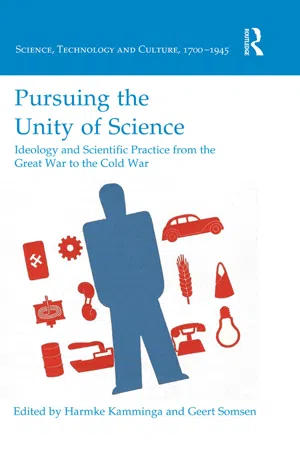
Pursuing the Unity of Science
Ideology and Scientific Practice from the Great War to the Cold War
- 244 pages
- English
- ePUB (mobile friendly)
- Available on iOS & Android
Pursuing the Unity of Science
Ideology and Scientific Practice from the Great War to the Cold War
About This Book
From 1918 to the late 1940s, a host of influential scientists and intellectuals in Europe and North America were engaged in a number of far-reaching unity of science projects. In this period of deep social and political divisions, scientists collaborated to unify sciences across disciplinary boundaries and to set up the international scientific community as a model for global political co-operation. They strove to align scientific and social objectives through rational planning and to promote unified science as the driving force of human civilization and progress. This volume explores the unity of science movement, providing a synthetic view of its pursuits and placing it in its historical context as a scientific and political force. Through a coherent set of original case studies looking at the significance of various projects and strategies of unification, the book highlights the great variety of manifestations of this endeavour. These range from unifying nuclear physics to the evolutionary synthesis, and from the democratization of scientific planning to the utopianism of H.G. Wells's world state. At the same time, the collection brings out the substantive links between these different pursuits, especially in the form of interconnected networks of unification and the alignment of objectives among them. Notably, it shows that opposition to fascism, using the instrument of unified science, became the most urgent common goal in the 1930s and 1940s. In addressing these issues, the book makes visible important historical developments, showing how scientists participated in, and actively helped to create, an interwar ideology of unification, and bringing to light the cultural and political significance of this enterprise.
Frequently asked questions
Information
1 Introduction
Unification in context
Unifying issues
Table of contents
- Cover
- Halftitle Page
- Routledge Page
- Title Page
- Copyright Page
- Contents
- List of figures
- Notes on contributors
- Preface
- Acknowledgements
- 1 Introduction
- 2 Meanings of scientific unity: the law, the orchestra, the pyramid, the quilt and the ring
- 3 The unifying vision: Julian Huxley, evolutionary humanism and the evolutionary synthesis
- 4 Unity through experiment? Reductionism, rhetoric and the politics of nuclear science, 1918–40
- 5 Scientists of the world unite: socialist internationalism and the unity of science
- 6 Government as scientific process in H.G. Wells’s world state
- 7 Unifying science against fascism: neuropsychiatry and medical education in the Spanish Civil War
- 8 ‘To formulate a plan for better living’: visual communication and scientific planning in Paul Rotha’s documentary films, 1935–45
- 9 Unifying science and human culture: the promotion of the history of science by George Sarton and Frans Verdoorn
- 10 The unity of knowledge and the diversity of knowers: science as an agent of cultural integration in the United States between the two world wars
- 11 McCarthyism in philosophy and the end of the unity of science ideology
- Index